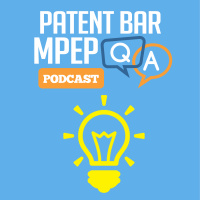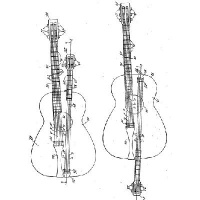Synopsis
Patent Bar Review
Episodes
-
MPEP Q & A 196: Submission of Petition to Withdraw Application from Issue Under 37 CFR 1.313(c)
28/04/2020 Duration: 03minQuestion: How can petitions to withdraw an application from issue under 37 CFR 1.313(c) be sent to the USPTO? Answer: Petitions to withdraw an application from issue under 37 CFR 1.313(c) may be: (A) mailed to “Mail Stop Petition, Commissioner for Patents”; (B) transmitted by facsimile; (C) hand-carried to the Office of Petitions; or (D) […] The post MPEP Q & A 196: Submission of Petition to Withdraw Application from Issue Under 37 CFR 1.313(c) appeared first on Patent Education Series.
-
MPEP Q & A 195: Necessary Items for a Petition for Retroactive License
14/04/2020 Duration: 03minQuestion: What should a petition for retroactive license include? Answer: A petition for retroactive license shall include: (1) A listing of each of the foreign countries in which the unlicensed patent application material was filed, (2) The dates on which the material was filed in each country, (3) A verified statement (oath or declaration) containing: […] The post MPEP Q & A 195: Necessary Items for a Petition for Retroactive License appeared first on Patent Education Series.
-
MPEP Q & A 194: Stop the Publication of an Application
31/03/2020 Duration: 03minQuestion: Can a petition under 37 CFR 1.138(c) stop publication of an application? Answer: A petition under 37 CFR 1.138(c) will not stop publication of the application unless it is recognized and acted on by the Pre-Grant Publication Division in sufficient time to avoid publication. The petition will be granted when it is recognized in […] The post MPEP Q & A 194: Stop the Publication of an Application appeared first on Patent Education Series.
-
MPEP Q & A 193: Petition to Make Special and Energy Resources
17/03/2020 Duration: 04minQuestion: Does the petition to make special apply to patent applications for inventions dealing with energy resources? Answer: The U.S. Patent and Trademark Office will, on petition, accord “special” status to all patent applications for inventions which materially contribute to: (A) the discovery or development of energy resources, or (B) the more efficient utilization and […] The post MPEP Q & A 193: Petition to Make Special and Energy Resources appeared first on Patent Education Series.
-
MPEP Q & A 192: Overcome Provisional Obviousness Rejection
03/03/2020 Duration: 04minQuestion: How can a provisional obviousness rejection be overcome? Answer: A provisional obviousness rejection can be overcome by: Arguing patentability over the earlier filed application; Combining the subject matter of the copending applications into a single application claiming benefit under 35 U.S.C. 120 of the prior applications and abandoning the copending applications Filing an affidavit […] The post MPEP Q & A 192: Overcome Provisional Obviousness Rejection appeared first on Patent Education Series.
-
MPEP Q & A 191: Final Rule in the Changes to the Claim Construction Standard
18/02/2020 Duration: 04minQuestion: What does the final rule in the “Changes to the Claim Construction Standard for Interpreting Claims in Trial Proceedings Before the Patent Trial and Appeal Board” state? Answer: In this final rule, the Office revises the rules to provide that a patent claim, or a claim proposed in a motion to amend, shall be […] The post MPEP Q & A 191: Final Rule in the Changes to the Claim Construction Standard appeared first on Patent Education Series.
-
MPEP Q & A 190: AIA Proceeding Expenses Under Phillips
04/02/2020 Duration: 04minQuestion: Have parties to AIA proceedings under Phillips required expanded page limits or otherwise incurred more expenses in their AIA trials than parties in AIA proceedings under BRI? Answer: PTAB has not found that parties to these AIA proceedings under Phillips require expanded page limits or otherwise incur more expense in their AIA trials than […] The post MPEP Q & A 190: AIA Proceeding Expenses Under Phillips appeared first on Patent Education Series.
-
MPEP Q & A 189: Issuance of NIRC Action in Inter Partes Reexamination Proceeding
21/01/2020 Duration: 04minQuestion: Name one instance when issuance of a NIRC action would be proper in an inter partes reexamination proceeding. Answer: The following are the only instances when issuance of a NIRC action would be proper in an inter partes reexamination proceeding: There is no timely response by the patent owner to an Office action requiring […] The post MPEP Q & A 189: Issuance of NIRC Action in Inter Partes Reexamination Proceeding appeared first on Patent Education Series.
-
MPEP Q & A 188: What Should Applicant Initiated Interview Request Form Identify?
07/01/2020 Duration: 02minQuestion: What should the Applicant Initiated Interview Request form identify? Answer: The Applicant Initiated Interview Request form should identify: the participants of the interview the proposed date of the interview whether the interview will be personal, telephonic, or video conference and should include a brief description of the issues to be discussed. Chapter Details: The […] The post MPEP Q & A 188: What Should Applicant Initiated Interview Request Form Identify? appeared first on Patent Education Series.
-
MPEP Q & A 187: Two Final Rules Dealing with Claim Construction Standard
10/12/2019 Duration: 04minQuestion: What are the two final rules dealing with the claim construction standard as implemented in the supplement entitled “Changes to the Claim Construction Standard for Interpreting Claims in Trial Proceedings Before the Patent Trial and Appeal Board”? Answer: In the first final rule, the Office changed the existing rules to, among other things: Increase […] The post MPEP Q & A 187: Two Final Rules Dealing with Claim Construction Standard appeared first on Patent Education Series.
-
MPEP Q & A 186: Name Types of Patents that May Not Use 37 C.F.R. 1.114
26/11/2019 Duration: 03minQuestion: Name two types of patents that may not use the provisions of 37 C.F.R. 1.114. Answer: The provisions of 37 C.F.R. 1.114 do not apply to the following types of patents: design patent applications provisional applications applications filed before June 8, 1995 international applications filed before June 8, 1995 an international design application reexamination […] The post MPEP Q & A 186: Name Types of Patents that May Not Use 37 C.F.R. 1.114 appeared first on Patent Education Series.
-
MPEP Q & A 185: What Must an Application Filed Under 37 CFR 1.53(d) be Filed Before the Earliest Of?
12/11/2019 Duration: 03minQuestion: What must an application filed under 37 CFR 1.53(d) be filed before the earliest of? Answer: An application filed under 37 CFR 1.53(d) must be filed before the earliest of: (A) payment of the issue fee on the prior application, unless a petition is granted in the prior application; (B) abandonment of the prior […] The post MPEP Q & A 185: What Must an Application Filed Under 37 CFR 1.53(d) be Filed Before the Earliest Of? appeared first on Patent Education Series.
-
MPEP Q & A 184: What Should a Subject Matter Eligibility Rejection Identify Under Step 2A?
29/10/2019 Duration: 04minQuestion: A subject matter eligibility rejection under Step 2 should provide an explanation for each part of the Step 2 analysis; Step 2A and Step 2B. What specifically should a rejection identify under Step 2A? Answer: For Step 2A, the rejection should identify the judicial exception by referring to what is recited (i.e., set forth or described) in the claim and explain why it is considered an exception. For example, if the claim is directed to an abstract idea, the rejection should identify the abstract idea as it is recited (i.e., set forth or described) in the claim and explain why it corresponds to a concept that… The post MPEP Q & A 184: What Should a Subject Matter Eligibility Rejection Identify Under Step 2A? appeared first on Patent Education Series.
-
MPEP Q & A 183: When Changes to the Claim Construction Standard Apply
15/10/2019 Duration: 04minQuestion: When will the changes to the claim construction standard as outlined in “Changes to the Claim Construction Standard for Interpreting Claims in Trial Proceedings Before the Patent Trial and Appeal Board” apply? Answer: As shown in the supplement … The changes to the claim construction standard will apply to proceedings where a petition is filed on or after the effective date of the final rule (November 13, 2018). The Office will apply the federal court claim construction standard, in other words, the claim construction standard that would be used to construe the claim in a civil action under 35 U.S.C.… The post MPEP Q & A 183: When Changes to the Claim Construction Standard Apply appeared first on Patent Education Series.
-
MPEP Q & A 182: Characteristics of Ex Parte Reexamination
01/10/2019 Duration: 04minQuestion: List one of the basic characteristics of ex parte reexamination. Answer: The basic characteristics of ex parte reexamination are as follows: Anyone can request reexamination at any time during the period of enforceability of the patent; In ex parte reexaminations, prior art considered during reexamination is limited to prior art patents or printed publications applied under the appropriate parts of 35 U.S.C. 102 and 103. Patents may also be applied in a double patenting rejection; A substantial new question of patentability must be present for reexamination to be ordered; If ordered, the actual reexamination proceeding is ex parte in… The post MPEP Q & A 182: Characteristics of Ex Parte Reexamination appeared first on Patent Education Series.
-
MPEP Q & A 181: Summary of Claim Construction Standard
17/09/2019 Duration: 04minQuestion: What is the executive summary of the final rule when dealing with the claim construction standard that took effect on November 13, 2018? Answer: This final rule revises the rules for IPR, PGR, and CBM proceedings that implemented provisions of the Leahy-Smith America Invents Act (‘‘AIA’’) providing for trials before the Office, by replacing the BRI (broadest reasonable interpretation) standard for interpreting unexpired patent claims and substitute claims proposed in a motion to amend with the same claim construction standard that would be used to construe the claim in a civil action under 35 U.S.C. 282(b). The rule adopts… The post MPEP Q & A 181: Summary of Claim Construction Standard appeared first on Patent Education Series.
-
MPEP Q & A 180: AIA 35 U.S.C. 102(b)
03/09/2019 Duration: 02minQuestion: What does AIA 35 U.S.C. 102(b) discuss? Answer: AIA 35 U.S.C. 102(b) sets forth exceptions to prior art established in AIA 35 U.S.C. 102(a). Chapter Details: The answer to this question can be found in chapter 2100 of the MPEP. This chapter covers Patentability. The answer is from the 9th Edition, Revision 08.2017. Depending on future changes to the MPEP, the question and answer may or may not be applicable in later Editions or revisions. Section Summary: This question and answer comes from section 2152 of the MPEP. The following is a brief summary of section 2152. 2152 Detailed… The post MPEP Q & A 180: AIA 35 U.S.C. 102(b) appeared first on Patent Education Series.
-
MPEP Q & A 179: What is the 3-Step Test for Recapture?
20/08/2019 Duration: 03minQuestion: What is the 3-step test for recapture? Answer: The three-step test for recapture is: First, we determine whether, and in what respect, the reissue claims are broader in scope than the original patent claims; Next, we determine whether the broader aspects of the reissue claims relate to subject matter surrendered in the original prosecution; and Finally, we determine whether the reissue claims were materially narrowed in other respects, so that the claims may not have been enlarged, and hence avoid the recapture rule. Chapter Details: The answer to this question can be found in chapter 1400 of the MPEP.… The post MPEP Q & A 179: What is the 3-Step Test for Recapture? appeared first on Patent Education Series.
-
MPEP Q & A 178: What is the Difference Between Derivation and Priority of Invention?
06/08/2019 Duration: 03minQuestion: What is the difference between derivation and priority of invention? Answer: Derivation and priority of invention both focus on inventorship. Derivation addresses originality, i.e., who invented the subject matter, whereas priority focuses on which party invented the subject matter first. Chapter Details: The answer to this question can be found in chapter 2100 of the MPEP. This chapter covers patentability. The answer is from the 9th Edition, Revision 08.2017. Depending on future changes to the MPEP, the question and answer may or may not be applicable in later Editions or revisions. Section Summary: This question and answer comes from… The post MPEP Q & A 178: What is the Difference Between Derivation and Priority of Invention? appeared first on Patent Education Series.
-
MPEP Q & A 177: Revealing Information Relating to the Representation of a Client When the Client has Not Given Informed Consent
23/07/2019 Duration: 03minQuestion: Can a patent practitioner ever reveal information relating to the representation of a client when the client has not given informed consent? Answer: Yes, a practitioner may reveal information relating to the representation of a client to the extent the practitioner reasonably believes necessary: (1) To prevent reasonably certain death or substantial bodily harm; (2) To prevent the client from engaging in inequitable conduct before the Office or from committing a crime or fraud that is reasonably certain to result in substantial injury to the financial interests or property of another and in furtherance of which the client has… The post MPEP Q & A 177: Revealing Information Relating to the Representation of a Client When the Client has Not Given Informed Consent appeared first on Patent Education Series.






